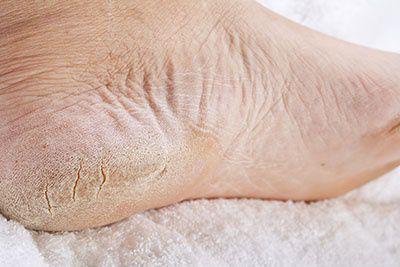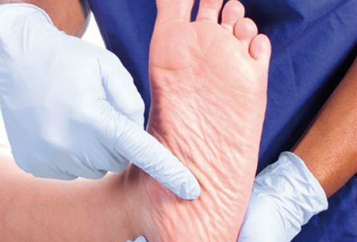Diabetic Foot Care
People with diabetes are at an increased risk for foot problems. When blood sugar levels are high, damage to the nerves in the feet can occur. This is why it is recommended that those who have diabetes or prediabetes have their feet examined and treated regularly by a foot specialist.
Diabetic Foot Conditions
Along with neurological symptoms, the diabetic foot can also have issues related to circulation. This can lead to slower healing time and loss of health and integrity to the skin. Some common conditions seen in Diabetic patients are:

- Dry skin
- Calluses
- Corns
- Fissures or cracks
- Thick and/or fungal toenails
- Ingrown toenails
- High or collapsed arches
- Diabetic Neuropathy
- Diabetic wounds or ulcers
- Toe deformity (ex. Clawed or hammertoe)
- Bunions
Diabetic Foot Conditions
At Temiskaming Foot Care, we perform a full comprehensive diabetic foot assessment. This assessment includes Vascular, Neurological, Musculoskeletal, Dermatological and Footwear components. This will determine your risk level. Based on this, a management plan will be created and all questions will be answered. This assessment will determine how frequently you are recommended to be seen by our Chiropodist.
Diabetic Neuropathy
Diabetic neuropathy is the loss of sensation to the feet due to high blood sugars damaging the nerves. This nerve damage affects the nerves that control sensation or feeling in the feet, those that control muscles and muscle movement as well as those that control autonomic function such as sweating or moisture content. Usually this process begins with numbness, tingling and burning in the feet and in later stages complete loss of sensation. Once neuropathy occurs it is very important to monitor the feet for any changes or damage. A Chiropodist can assist with this management.
Diabetic Wound or Ulcer
 A wound or ulcer is an opening in the skin anywhere on the foot, ankle or leg. This happens as the
patient is unable to feel any trauma or changes occurring. The nerve damage also decreases the body’s
immune response to heal itself. If left untreated, the patient is at risk for infection and in some cases
loss of limb. It is very important for ulcers to be managed by your health care provider regularly to
prevent an adverse outcome. A Chiropodist will accomplish this by routinely removing damaged tissue to
allow for healthy tissue growth and wound closure.
A wound or ulcer is an opening in the skin anywhere on the foot, ankle or leg. This happens as the
patient is unable to feel any trauma or changes occurring. The nerve damage also decreases the body’s
immune response to heal itself. If left untreated, the patient is at risk for infection and in some cases
loss of limb. It is very important for ulcers to be managed by your health care provider regularly to
prevent an adverse outcome. A Chiropodist will accomplish this by routinely removing damaged tissue to
allow for healthy tissue growth and wound closure.
Tips for Diabetic Foot Care
. Perform daily checks of your feet for any changes
. Wear white socks so that any bleeding or fluid is easier to spot
. Wear a stable pair of footwear indoors to protect your feet
. Keep feet clean and dry, especially between the toes
. Ensure all socks/footwear are properly fitting without seams or ridges creating pressure points
. Regularly moisturize your feet
. If any unexpected changes or trauma occur, seek treatment from your Chiropodist right away